In 1845, Robert F. Bridgforth of Mecklenburg County, Virginia sold his land, purchased 2,800 acres of land in Yazoo County, Mississippi, and moved his family and over 40 enslaved people to the Vaughan area. One of them was a young man named Jacob. I have concluded with great certainty that Jacob was my father’s maternal great-great-grandfather. He was forever separated from at least one young daughter, Amelia, who was eventually taken to southern Georgia.
Jacob’s second family included his daughter, Frances Morris Bass McAllister, who was my father’s great-grandmother, and his sons, Jacob and Edward. Genealogy research uncovered that they and their mother, Caroline Morris, resided on Col. John Hebron’s plantation called LaGrange, east of Vicksburg, Mississippi, after the Civil War. When 2,500 Union troops overtook LaGrange in 1863, General Ulysses S. Grant converted it into a Union headquarters and contraband camp during the Civil War.
Jacob was inventoried on Robert Bridgforth’s 1851 estate record, but he was not found anywhere afterwards. This appears to indicate that he may have died before or during the Civil War or before 1870. His children selected the surname Morris instead of Bridgeforth.
Much of this was discovered within the past five years. Before then, I was unaware that my family had ancestral ties to Yazoo County, about 20 miles north of my hometown, Canton. Both genealogy and DNA helped me to establish some of the aforementioned facts. Let’s look at the following ten “ladder steps:”
Ladder Step 1: 1880 Census, Warren County, Mississippi, John “Jack” & Frances Bass
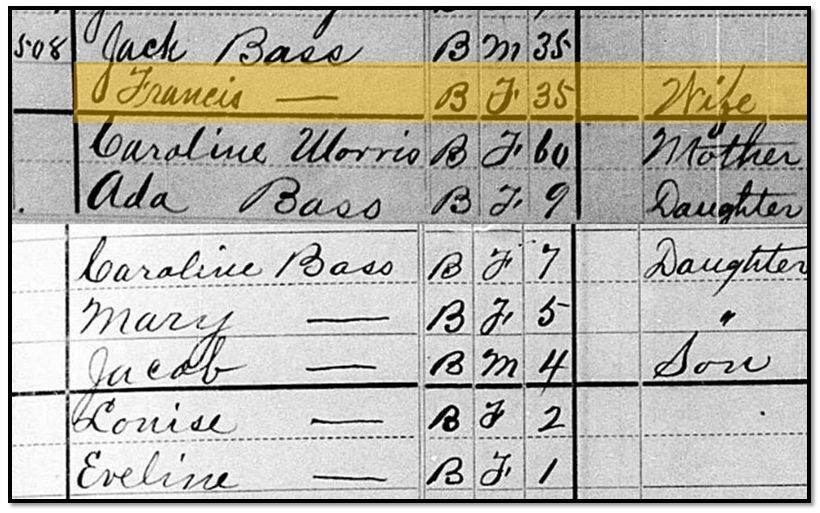
Frances’s mother, Caroline Morris, was in the household, although the census-taker erroneously recorded her as being Jack’s mother. Virginia was reported as the birthplace of Frances’s parents, while Jack was born in North Carolina (Northampton County). John Bass and Frances Morris’s marriage certificate show that they had married in February 1869 in Warren County. They had two additional daughters, my great-grandmother Angeline Bass and Mariah Bass, who were born shortly after this census. Only one son, named Jacob Bass, was born to them.
Ladder Step 2: The John Diggs Genetic Group
I was surprised to see that my father had some good DNA matches out of Yazoo County, Mississippi. After a lot of DNA sleuthing, critical thinking, and researching the family trees of those DNA matches, I discovered that my father shares DNA with descendants of a couple, John Henry and Almedia McClain Diggs of Yazoo County. Here’s a chart of six of them, from three of their children, that I was able to find.
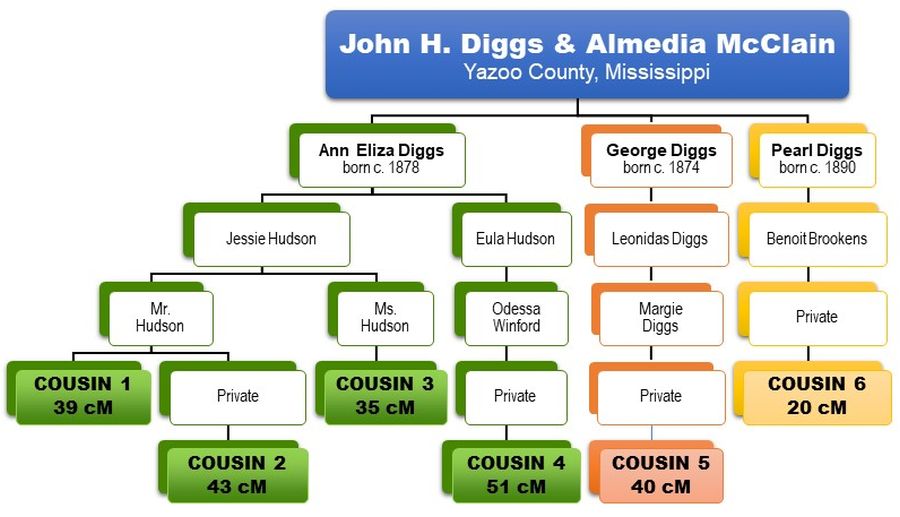
Ladder Step 3: John Diggs’s Military Service Record
In Ancestry.com, I received a hint to a John H. Diggs from Yazoo County, who was a soldier in the Civil War. He had fought with Company K of the 5th United States Colored Heavy Artillery Regiment. This John certainly matched the same John Henry Diggs I was researching.

Ladder Step 4: John H. Diggs’s Civil War Pension
When I visited the National Archives in D.C. to find his pension file, the following document in it provided his date and place of birth – the Bridgeforth Place. This was major!
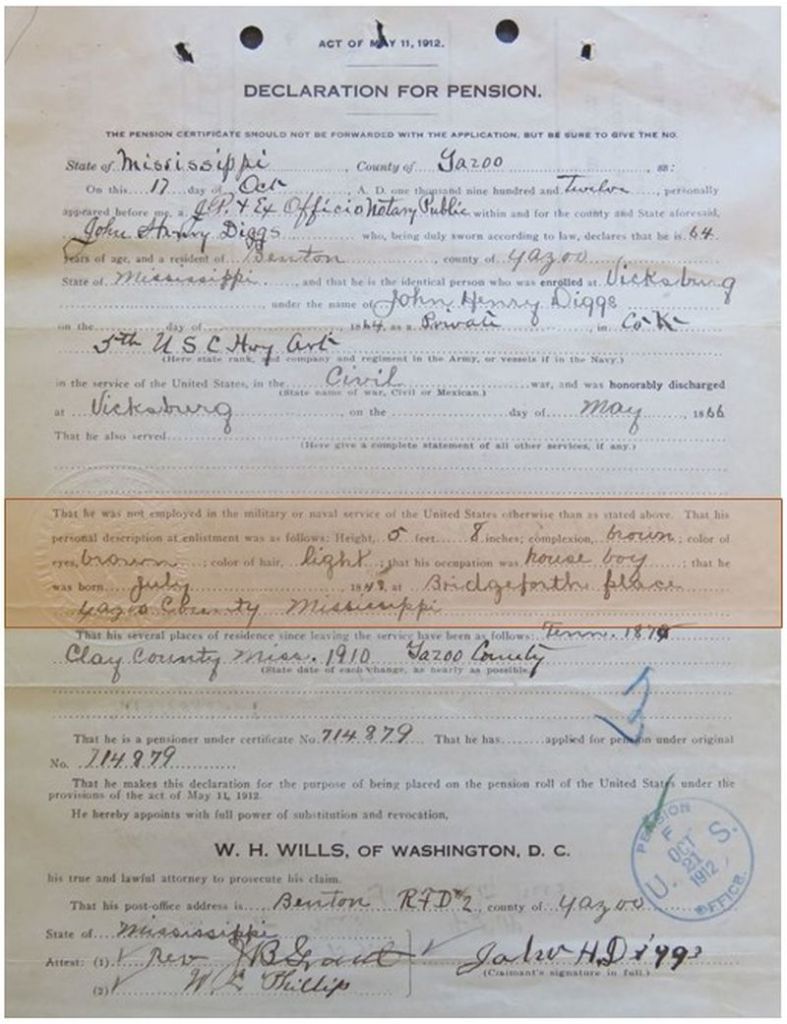
His description was recorded as follows: height 5 feet 8 inches; complexion, brown; color of eyes, brown; color of hair, light; his occupation, house boy; Born July 25, 1848 on the Bridgforth Place, Yazoo County, Mississippi.
Ladder Step 5: 1880 Census, Yazoo County, Mississippi, Sidney Bridgforth & Nancy Scott
In the 1880 Census, John & Almedia Diggs’s young children were in the household of their grandmother, Nancy, and her husband, George Scott. Per the 1880 census, John and Almedia had gone to Milan, Tennessee for a brief period but came back to Yazoo County. Nancy’s birthplace was recorded as Virginia.

Ladder Step 6: The Sidney Bridgforth Genetic Group
Among my father’s numerous DNA matches out of Yazoo County were at least two descendants of Sidney Bridgforth. See below. As you see above in Ladder Step 5, he lived next door to John Diggs’s mother and noted as being “mulatto.” I theorize that Sidney was another son of Nancy. One of the two DNA matches who descends from Sidney shared with me that their family lore proclaimed that one of Robert Bridgforth’s sons fathered Sidney, and white Bridgforth descendants were indeed DNA matches to him.
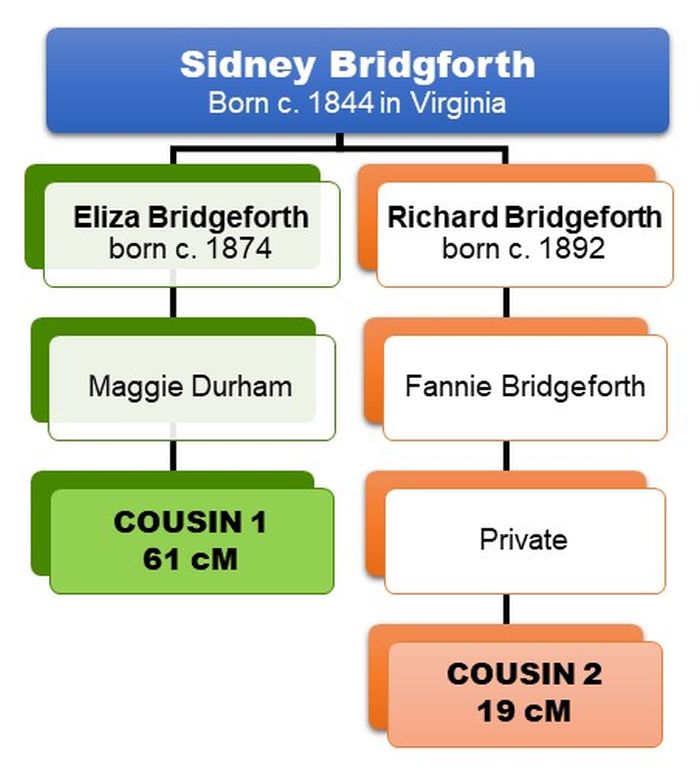
Ladder Step 7: “The Bridgforth Place,” 1850 Slave Schedule, Yazoo County, Mississippi
Per the 1850 Slave Schedule, a total of seventy-five (75) people were enslaved by the Bridgforth Family near Vaughan. Robert F. Bridgforth “owned” 54 slaves, and his sons, James and Robert M. Bridgforth, owned 21 slaves.

Ladder Step 8: The Amelia Leary Genetic Group
Shared DNA matches is what I consider the most important tool in AncestryDNA. It shows you other people who shares DNA (20 cM and over) with a match. So, when I clicked on and studied the “Shared Matches” with John Diggs and Sidney Bridgforth’s descendants, I discovered yet another genetic group! And to my surprise, these two DNA cousins both descend from Charles & Amelia Leary of Columbus, Georgia. They had no ties to Mississippi. Cousin 1 below took the 23andMe test, and she shares DNA on the X-chromosome with my father. 23andMe provides a “super important” chromosome browser. Interestingly, Amelia’s birthplace was consistently recorded as Virginia. So, she appeared to be the link to our DNA connection. But, how?
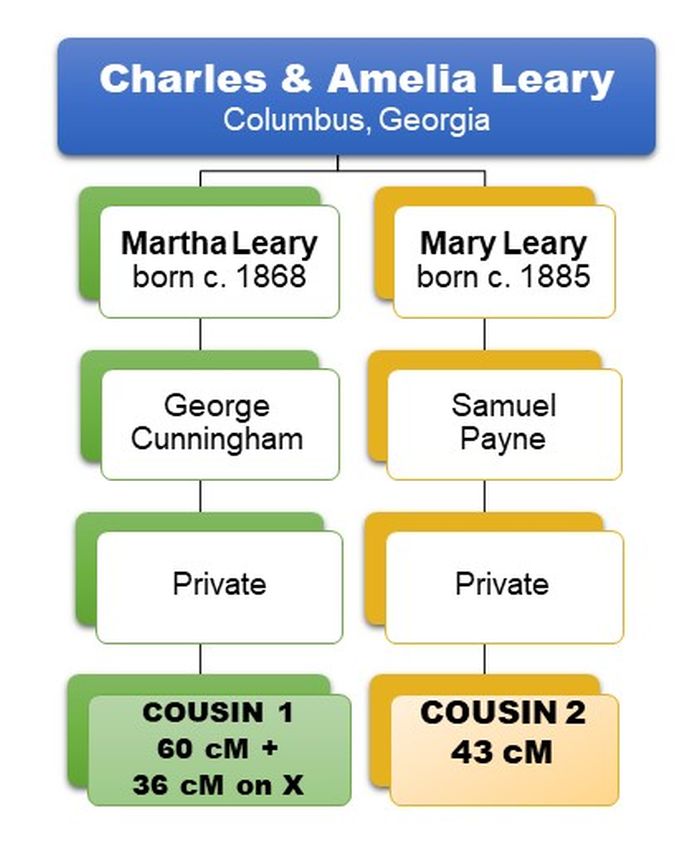
Ladder Step 9: Amelia Leary’s 1929 Death Certificate, Columbus, Georgia
Fortunately, I found a death certificate for Amelia Leary, and it gave the father’s name, “Jacob Bridgefoot.” This was major! Her daughter, Moselle Leary, with whom she was living on 510 Macon Street, was the informant.

Ladder Step 10: Robert Bridgforth’s 1851 Probate Record, Yazoo County, Mississippi
Robert F. Bridgforth died in 1851 in Yazoo County. In his will, he left all of his estate to his wife, Martha. None of his 50+ enslaved people were named. Fortunately, FamilySearch.org has digitized Yazoo County probate records, and I found an inventory of Robert Bridgforth’s estate, dated March 1851. The names of 48 enslaved people included “Jacob, 29 years old.” See below. This was my Jacob!

This case and more “ladder steps” were part of my 2020 Legacy Webinar entitled, “The Second Middle Passage: Following the DNA Trails.” Had it not been for DNA technology, I probably would have never found Jacob. Genealogy and DNA are indeed an indelible marriage.

My father’s maternal line is Bridgeforth/Bridgforth, with my 3rd great grandfather Green Bridgeforth 1843-1915. I ran into roadblocks in my research, but my DNA came back with matches of family in Yahoo MS. I just did a google search and got here. Thank you for your research and this website. I’m sure all the dots will connect.
Peace and Love,
Jay Green
Richmond, VA
LikeLiked by 1 person